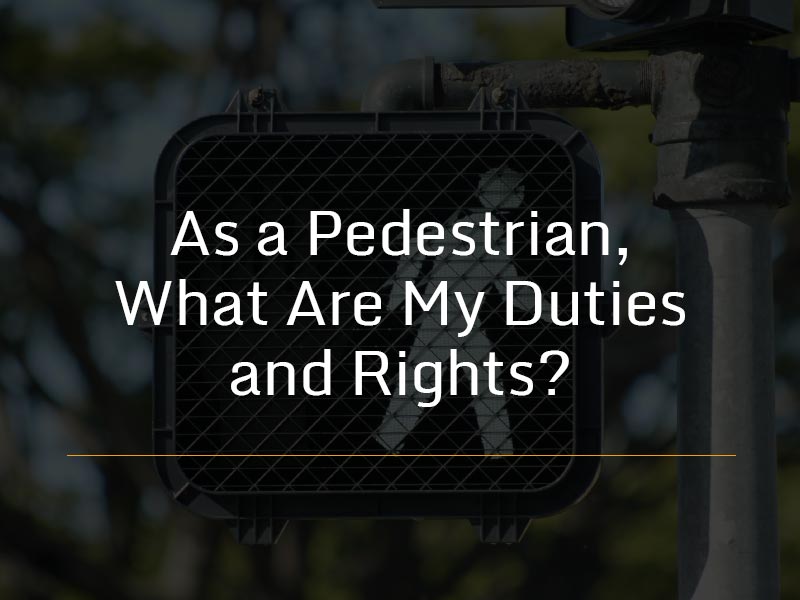What Is The Duty of a Pedestrian?
Click For Free Consultation
Legally Reviewed By: Robert M. Knowles
Attorney & Partner At Knowles Law Firm
Many people assume that because pedestrians are the road’s most vulnerable users, they do not have any responsibilities in terms of safety or roadway rules. While pedestrians are at the greatest risk of injury in accidents, they still have traffic laws they must obey. Nebraska has state and municipal laws outlining pedestrian responsibilities when navigating the streets and sidewalks. Before you decide to walk or jog around Nebraska, learn your duties to help prevent an accident.
Understanding pedestrian safety is crucial to avoid accidents with distracted drivers and to know your rights and duties under the law.

Know the Rights-of-Way and Traffic Laws
Pedestrians do not automatically bear the right-of-way. Like other roadway users, they must yield the right-of-way when appropriate. Even when the road has a marked crosswalk, pedestrians do not always have the right to cross. Many pedestrian accidents occur when the person walking or jogging mistakenly believes they have the right-of-way and steps out into traffic. Similarly, many drivers struggle with understanding rights-of-way and may try to turn left or right into crossing pedestrians. Learn Nebraska’s right-of-way laws to keep yourself and others safe.
- At Signalized Crosswalks and Intersections: If the intersection has a pedestrian traffic control device, you may only proceed into the crosswalk when the WALK or pedestrian icon appears. Do not start crossing if you see a flashing red hand or a DON’T WALK signal. It is crucial to obey traffic control signals at intersections to ensure safety.
- At Crosswalks and Intersections Without Signals: Without a traffic control device, you have the right of way to cross. However, you may not step out in front of a vehicle if it does not have enough time to stop. You must give oncoming motor vehicles the right of way if they are approaching fast enough to constitute a hazard.
- At Places Other Than Intersections: Try to cross the street only at intersections. You do not have the right-of-way when crossing anywhere other than a crosswalk or intersection (jaywalking). You must stay on the curb and wait until the road is clear to cross.
The safest place to cross the street is at a corner. Marked and unmarked intersections are safer than crossing midblock. When in doubt, stand safely on the curb until oncoming vehicles pass or come to complete stops. Make eye contact with drivers, if you can, to make sure they see you. Do not step out from behind a parked vehicle, hedge, sign, or another obstacle, as oncoming drivers may not see you. Always watch for pedestrians and crosswalk signals and obey them when in use. When crossing a street with multiple lanes, make sure the cars have stopped in each lane before proceeding.
Pay Attention to Pedestrian Safety
It is also a pedestrian’s duty to pay attention to the road or sidewalk and obey traffic signals. Just as a driver must watch the road when driving, a pedestrian has a responsibility to watch where he or she is going. As a pedestrian, you should always look at traffic signs and signals, be aware of your surroundings, watch for cars, and pay attention to where you are walking. Following pedestrian crossing rules is crucial for your safety and the safety of others. Do not listen to headphones, talk on the phone or look down at your cellphone as you walk. Listen to the sounds of approaching vehicles. Do not assume it is safe to cross just because the person next to you steps out into the road. Never try to walk home after drinking alcohol. Pedestrian intoxication is a leading cause of accidents. Trust a sober friend to drive you home, take the bus, or hail a cab or Uber vehicle.
Use Sidewalks and Marked Crosswalks
It is generally against the law for a pedestrian to walk in the street if a sidewalk or pedestrian passageway is available. It is also unsafe. Always use a sidewalk if one is available. Walk in the direction opposing traffic so you are facing oncoming vehicles. This can give you time to react and move out of the way if you see a vehicle about to strike you. If you have to walk in the street, stay as far to the right-hand side of the road as possible. Get to a street that has a sidewalk as soon as you can.
Legal Recourse for Injured Pedestrians
Pedestrian accidents can result in serious pedestrian injuries and significant financial burdens. If you have been injured as a pedestrian due to a driver’s negligence, it is important to understand your legal rights and the steps you can take to seek compensation. Motor vehicle drivers have a responsibility to prevent pedestrian accidents by yielding the right-of-way at crosswalks and exercising care to avoid striking pedestrians.
Here’s an overview of the legal recourse available for injured pedestrians:
Filing a Personal Injury Claim
If you are injured in a pedestrian accident, you can file a personal injury claim against the at-fault driver. This process typically involves the following steps:
- Seek Medical Attention: Your health is the top priority. Ensure you receive medical care immediately and follow all prescribed treatments.
- Document the Accident: Collect evidence from the scene, including photos, witness statements, and the driver’s contact information. Keep records of your medical treatments and expenses.
- Notify the Driver’s Insurance Company: Inform the at-fault driver’s insurance company about the accident and your intention to file a claim. Provide them with the necessary documentation and evidence.
Compensation for Pedestrian Injuries
Pedestrians injured in accidents may be entitled to various forms of compensation, including:
- Medical Expenses: Compensation for all medical costs related to the accident, including emergency room visits, hospital stays, surgeries, medications, physical therapy, and any future medical treatments.
- Lost Wages: Reimbursement for income lost due to time off work while recovering from injuries. If your injuries result in long-term disability, you may also be entitled to compensation for loss of earning capacity.
- Pain and Suffering: Compensation for the physical pain and emotional distress caused by the accident. This includes anxiety, depression, and any impact on your quality of life.
- Property Damage: Reimbursement for any personal property damaged in the accident, such as clothing, electronic devices, or other personal items.
- Punitive Damages: In cases where the driver’s behavior was particularly reckless or egregious, you may be awarded punitive damages, which are intended to punish the wrongdoer and deter similar conduct in the future.
Statute of Limitations
It is crucial to be aware of the statute of limitations for filing a personal injury claim. In Nebraska, the statute of limitations for personal injury claims is generally four years from the date of the accident. Failing to file within this timeframe can result in losing your right to seek compensation.
Steps to Take After a Pedestrian Accident
Taking the right steps after a pedestrian accident can strengthen your case and improve your chances of receiving fair compensation:
- Report the Accident: Contact the police and file an accident report. Ensure you obtain a copy of the report for your records.
- Gather Evidence: Collect as much evidence as possible from the accident scene, including photos, witness contact information, and any available surveillance footage.
- Keep Detailed Records: Maintain a detailed record of all medical treatments, expenses, and any communication with insurance companies.
- Avoid Giving Statements: Do not provide recorded statements to the insurance company without consulting an attorney first. Anything you say can be used against you in the claim process.
- Consult an Attorney: Seek the advice of an experienced personal injury attorney who can guide you through the legal process, protect your rights, and advocate on your behalf.
How an Attorney Can Help
An experienced personal injury attorney can provide invaluable assistance in navigating the complexities of a pedestrian accident claim:
- Legal Advice: Offer expert guidance on your legal rights and options.
- Investigation: Conduct a thorough investigation to gather evidence and establish liability.
- Negotiation: Handle negotiations with the insurance company to seek a fair settlement.
- Representation: Represent you in court if a fair settlement cannot be reached, ensuring your case is presented effectively.
If you have been injured in a pedestrian accident, it is important to take prompt action to protect your rights and seek the compensation you deserve. The Knowles Law Firm is dedicated to helping injured pedestrians navigate the legal process and achieve the best possible outcome. Contact us today at (402) 431-9000 or fill out a contact form for a free consultation to discuss your case and learn how we can assist you in securing the compensation you need to recover and move forward.

About Our Attorney
Robert M. Knowles
Attorney & Partner at Knowles Law Firm
Robert has tried cases in both state and federal courts and was selected as one of the top 100 litigation lawyers in Nebraska for 2014 by the American Society of Legal Advocates. Less than 1.5 percent of lawyers nationally are selected for this recognition. He is rated AV by Martindale-Hubbell which is the highest rating an attorney can obtain. He was also selected by Martindale-Hubbell as a 2019 Top Rated Lawyer.
